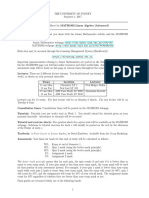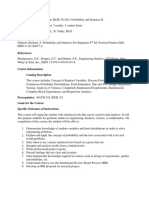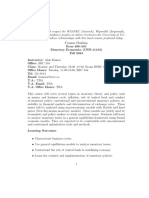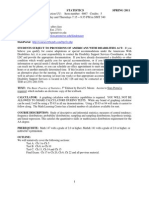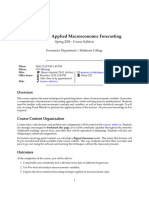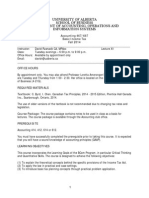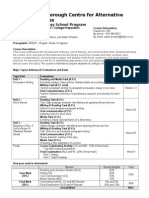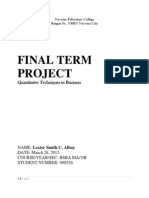Math 1005 Statistics
Math 1005 Statistics
Uploaded by
suitup10Copyright:
Available Formats
Math 1005 Statistics
Math 1005 Statistics
Uploaded by
suitup10Copyright
Available Formats
Share this document
Did you find this document useful?
Is this content inappropriate?
Copyright:
Available Formats
Math 1005 Statistics
Math 1005 Statistics
Uploaded by
suitup10Copyright:
Available Formats
THE UNIVERSITY OF SYDNEY
Semester 2, 2016
Information Sheet for MATH1005 Statistics
Websites: It is important that you check both the Junior Mathematics website and the MATH1005
website regularly.
Junior Mathematics webpage: http://www.maths.usyd.edu.au/u/UG/JM/
MATH1005 webpage: http://www.maths.usyd.edu.au/u/UG/JM/MATH1005
Both sites may be accessed through the Learning Management System (Blackboard):
https://elearning.sydney.edu.au.
Important announcements relating to Junior Mathematics are posted on the Junior Mathematics page.
On the MATH1005 page you will find online resources and other useful links. Announcements regarding
assessment tasks will be made on this page at various times throughout the semester.
Lectures: There are 4 different lecture streams. You should attend one stream (that is, two lectures per
week), as shown on your personal timetable.
Times
8am Mon & Tue
11am Mon & Tue
1pm Mon
1pm Tue
1pm Mon
10am Tue
Location
E Ave Aud
E Ave Aud
E Ave Aud
ASB Aud (B2010)
Messel LT (SNH)
Chemistry LT3
Lecturer
Dr. Di Warren, Carslaw 527
Dr. Di Warren, Carslaw 527
Winny Suhana
Prof. Neville Weber, Carslaw 823
Tom Porter, Carslaw 806
Shila Ghazanfar, Carslaw 807
Lectures run for 13 weeks. The first lecture will be on Monday 25 July. The last lecture will be on
Tuesday 25 October.
Consultation times: Consultation times will be posted on the MATH1005 webpage.
Tutorials: Tutorials (one per week) start in Week 2. You should attend the tutorial given on your
personal timetable. Attendance at tutorials will be recorded. Your attendance will not be recorded
unless you attend the tutorial in which you are enrolled.
Tutorial and exercise sheets: The question sheets for a given week will be available on the MATH1005
webpage. Solutions to tutorial exercises for week n will usually be posted on the web by the afternoon
of the Friday of week n.
Reference book: The following E-Text ($50) is not compulsory, but is helpful extra reading. David
Freedman, Robert Pisani and Roger Purves. Statistics. Norton, 2007. ISBN: 978-0-393-52210-5.
Assessment: Your final raw mark for this unit of study will be calculated as follows:
65%:
5%:
5%:
5%:
10%:
5%:
5%:
Exam at end of Semester 2.
Quiz 1 mark (using the better mark principle).
Quiz 2 mark (using the better mark principle).
Quiz 3 mark (using the better mark principle).
Assignment 1 mark.
Assignment 2 mark.
Assignment 3 mark.
The better mark principle means that for each quiz, the quiz counts if and only if it is better than or
equal to your exam mark. If your quiz mark is less than your exam mark, the exam mark will be used for
that portion of your assessment instead. For example, if your quiz 1 mark is better than your exam mark
while your quiz 2 and quiz 3 marks are worse than your exam mark, then the exam will count for 75%,
quiz 1 will count for 5%, and the assignments will count for 20% of your overall mark. The assignment
marks count for 20% regardless of whether they are better than your exam mark or not.
1
Final grades are returned within one of the following bands:
High Distinction (HD), 85100: representing complete or close to complete mastery of
the material; Distinction (D), 7584: representing excellence, but substantially less than
complete mastery; Credit (CR), 6574: representing a creditable performance that goes
beyond routine knowledge and understanding, but less than excellence; Pass (P), 5064:
representing at least routine knowledge and understanding over a spectrum of topics and
important ideas and concepts in the course.
A student with a passing or higher grade should be well prepared to undertake further studies in mathematics which are dependent on this unit of study.
Examination: There is one examination of 1.5 hours duration during the examination period at the
end of Semester 2. Further information about the exam will be made available at a later date on the
website.
Quizzes: Quizzes will be held during tutorials. You must sit for the quiz during the tutorial in which you
are enrolled, unless you have a Permission Slip from the Student Services Office, issued only for verifiable
reasons. Otherwise, your quiz mark may not be recorded.
Assignments: There are three assignments, which must be submitted electronically, as PDF files
only, in Turnitin (an internet-based plagiarism-prevention service), via the Learning Management System
(Blackboard) website by the deadline. Note that your assignment will not be marked if it is illegible or if
it is submitted sideways or upside down. It is your responsibility to check your submission receipt (which
will be automatically emailed to you) to ensure that your assignment has been submitted correctly.
Assessment and feedback schedule:
Task
Assignment 1
Quiz 1
Assignment 2
Quiz 2
Assignment 3
Quiz 3
Available
Fri 5 Aug
Fri 2 Sep
Fri 7 Oct
Deadline/date
11:59pm Mon 15 Aug
2326 Aug (Week 5)
11:59pm Mon 12 Sep
2023 Sep (Week 9)
11:59pm Mon 17 Oct
2528 Oct (Week 13)
Latest extension*
11:59pm Mon 22 Aug
11:59pm Mon 19 Sep
11:59pm Mon 24 Oct
Feedback
9 am Tue 23 Aug
30 Aug2 Sep (Week 6)
9 am Tue 20 Sep
47 Oct (Week 10)
9 am Tue 25 Oct
Study Vacation
* Extensions for assignments are only possible for students registered with Disability Services or applying
for Special Consideration or Special Arrangements.
Special consideration and special arrangements: While studying at the University of Sydney, you
may need to apply for special consideration or special arrangements as follows:
Special consideration may be granted to students where well-attested illness, injury, or misadventure occurs to them (or someone they have carers responsibility for) during the semester or
the exam period. Special arrangements may be granted for essential community commitments.
Further information on eligibility, document requirements, and how to apply is available
at http://sydney.edu.au/science/cstudent/ug/forms.shtml#special_consideration.
Applications must be made using the Universitys formal application process.
Final examinations will be held in the formal examination period. Students affected by illness,
injury or misadventure may lodge a request for Special Consideration to sit a replacement
examination in the formal Replacement Examination period i.e. in the two weeks following
the formal examination period.
If you are registered with Disability Services and would like to have adjustments applied to
the replacement examination, you are required to amend your Academic Plan with Disability
Services specifically for this replacement examination. This needs to be done as soon as you
are notified of award of the replacement opportunity. If you have not done so, you will be
allowed to sit the replacement, but under unadjusted conditions.
You should not submit an application of either type
if you are absent from a tutorial and there is no assessment associated with the missed tutorial, or
if you miss a quiz, since the better mark principle applies.
The assessment category for the assignments is Submitted Work.
Any questions? Before you contact us with any enquiry, please check the FAQ page:
http://www.maths.usyd.edu.au/u/UG/JM/FAQ.html.
Where to go for help: For administrative matters, go to the Student Services Office, Carslaw 520.
For help with mathematics, see your lecturer, your tutor, a duty tutor, or use the Ed discussion forum
(https://edstem.com.au). Lecturers guarantee to be available during their indicated office hours, but
may be available at other times as well. If you are having difficulties with mathematics due to insufficient
background, you may seek help from the Mathematics Learning Centre, Carslaw 455. You may also email
questions about the subject to MATH1005@maths.usyd.edu.au. Ensure that any emails that you send to
this address contain your name and SID, because anonymous emails will be ignored.
Objectives: The objectives of this unit are to:
introduce techniques for summarising experimental univariate and bivariate data, such as that
obtained in various branches of science, medicine, commerce etc, by means of elementary statistics
and diagrams;
use probability theory to provide a mathematical framework for real life data modelling;
introduce statistical inference and show how statistical tests can provide evidence for or against a
given scientific hypothesis.
Outcomes: Students who successfully complete this unit should be able to:
explain univariate and bivariate data by means of the five number summary, mean, variance and
standard deviation, correlation coefficient, boxplot, histogram and scatterplot;
find the least squares regression line as a way of describing a linear relationship in bivariate data;
use methods derived from the three axioms of probability to calculate the probabilities of simple
events;
understand the concept of a random variable and the meaning of the expected value and variance;
apply the Binomial distribution as a model for discrete data;
use the Normal distribution as a model for continuous data;
understand the central limit theorem;
understand the concept of hypotheses tests and p-values for finding evidence for or against simple
null hypotheses; in particular using the binomial test for testing proportions, one- or two-sided Z-,
t- or sign-test for making inferences about the population mean;
understand the concept of a confidence interval;
use the chi-squared test for simple goodness-of-fit problems;
use the R statistical computing environment to obtain numerical and graphical summaries of data,
and for performing various statistical calculations.
Proposed week-by-week outline:
Week
Topics
PART 1: EXPLORATORY DATA ANALYSIS
Topic 1: Data and Graphical Summaries
Topic 2: Numerical Summaries
Topic 3: Bivariate Data
PART 2: PROBABILITY THEORY AND DISTRIBUTION THEORY
Topic 4: Probability, Random Variables, and Distributions
Topic 5: Discrete Random Variables
Topic 6: Continuous Random Variables
Topic 7: Combinations of Random Variables
PART 3: HYPOTHESIS TESTING
Topic 8: Hypothesis Testing
Topic 9: Tests for Proportion
Break
10
Topic 10: Tests for Means
11
Topic 11: Test for Goodness of Fit
12
Topic 12: Confidence Intervals
13
Revision
You might also like
- Math 112 LMUDocument5 pagesMath 112 LMUVijay PalanivelNo ratings yet
- Liberal Arts Mathematics MAT 105 Spring 2020: Reasoning-Approach/dp/0357022610Document4 pagesLiberal Arts Mathematics MAT 105 Spring 2020: Reasoning-Approach/dp/0357022610Shaun WahlstromNo ratings yet
- Study Guide WTW 165 2020Document24 pagesStudy Guide WTW 165 2020charlieNo ratings yet
- PSYC 201 SyllabusDocument5 pagesPSYC 201 SyllabusMichael AntryNo ratings yet
- Statistics Formula TablesDocument8 pagesStatistics Formula TablesSamantha RodriguezNo ratings yet
- CS85: Data Stream Algorithms Lecture Notes, Fall 2009: Amit Chakrabarti Dartmouth CollegeDocument61 pagesCS85: Data Stream Algorithms Lecture Notes, Fall 2009: Amit Chakrabarti Dartmouth CollegearnettmoultrieNo ratings yet
- MATH1902 - Course OutlineDocument4 pagesMATH1902 - Course OutlineRoy LinNo ratings yet
- Math 10 Elementary Statistics: Course Information Contact InformationDocument4 pagesMath 10 Elementary Statistics: Course Information Contact Informationricardo2aguilar2castNo ratings yet
- MATH 312 SyllabusDocument4 pagesMATH 312 SyllabusAnh Nguyen100% (1)
- UMUCStats SyllabusDocument13 pagesUMUCStats SyllabusldlewisNo ratings yet
- McDaniel 315 S20-2Document6 pagesMcDaniel 315 S20-2Justin WienerNo ratings yet
- MAT100 AC2 SyllabusDocument4 pagesMAT100 AC2 Syllabuskj19438No ratings yet
- Probability and Statistics II Syllabus Spring 2022 - StudentDocument7 pagesProbability and Statistics II Syllabus Spring 2022 - StudentSabir AliNo ratings yet
- Math101 202301 Syllabus-3Document3 pagesMath101 202301 Syllabus-3otlacasNo ratings yet
- Lomeli M329F F20 WebDocument5 pagesLomeli M329F F20 WebRohan xDNo ratings yet
- Stat260 OutlineA0102 Jan2020Document6 pagesStat260 OutlineA0102 Jan2020UtghiiNo ratings yet
- STAT 240: Statistical Analysis: Section Syllabus - Spring2020Document5 pagesSTAT 240: Statistical Analysis: Section Syllabus - Spring2020Alexis R. CamargoNo ratings yet
- MATH 472 002/992: Numerical Methods With Financial ApplicationsDocument3 pagesMATH 472 002/992: Numerical Methods With Financial ApplicationswasabiwafflesNo ratings yet
- Syllabus For Che 5100bme5010Document3 pagesSyllabus For Che 5100bme5010JoseNo ratings yet
- Economics 3125-001-002-003-Spring23-MetzgarDocument8 pagesEconomics 3125-001-002-003-Spring23-MetzgarGeo TNo ratings yet
- ECON 101 PlanDocument5 pagesECON 101 PlanLemma BaliNo ratings yet
- ACG3101 - Financial Accounting and Reporting 1 - 04AA-04AB-3252 - Hinson, LDocument5 pagesACG3101 - Financial Accounting and Reporting 1 - 04AA-04AB-3252 - Hinson, Lmasondonovan033No ratings yet
- FIN300 Course Outline, S6, F13Document7 pagesFIN300 Course Outline, S6, F13Alex JonesNo ratings yet
- MTH 111sylabusfallDocument5 pagesMTH 111sylabusfallaiden.d.westNo ratings yet
- SyllabusDocument6 pagesSyllabusWallace WyattNo ratings yet
- econ_406_fall_2024_a01Document7 pagesecon_406_fall_2024_a01zamirNo ratings yet
- Course Syllabus MATH-2212 - Calculus of One Variable II: Fall Semester, 2016Document6 pagesCourse Syllabus MATH-2212 - Calculus of One Variable II: Fall Semester, 2016Latesha RobinsonNo ratings yet
- ECON 310 - Statistics Mckelvey-SyllabusDocument5 pagesECON 310 - Statistics Mckelvey-Syllabuscheekylix2004No ratings yet
- ECON102 SyllabusDocument4 pagesECON102 Syllabushybukub843No ratings yet
- Stat 2032Document8 pagesStat 2032Karthik GurusamyNo ratings yet
- 2014 Fall MATH 100 LECTURE EE1Document4 pages2014 Fall MATH 100 LECTURE EE1tuongphan0420No ratings yet
- Econ 1Bb3: Introductory Macroeconomics Sections C01, C02 Mcmaster University Fall, 2015Document6 pagesEcon 1Bb3: Introductory Macroeconomics Sections C01, C02 Mcmaster University Fall, 2015Labeeb HossainNo ratings yet
- Generalsyllabusm 121 S 2017Document3 pagesGeneralsyllabusm 121 S 2017Nikhil ArjunNo ratings yet
- Departmental Syllabus For MAT 284, Business Calculus. Spring 2014Document4 pagesDepartmental Syllabus For MAT 284, Business Calculus. Spring 2014Anonymous bZTdTpLNo ratings yet
- Math 256 Statistics Spring 2011Document5 pagesMath 256 Statistics Spring 2011Laksamana NusantaraNo ratings yet
- MATH323 Winter2024Document6 pagesMATH323 Winter2024Hash BrakeNo ratings yet
- Mathematics For Financial AnalysisDocument5 pagesMathematics For Financial AnalysisdaweiliNo ratings yet
- MATH 113-K01 Fall 2024 SyllabusDocument5 pagesMATH 113-K01 Fall 2024 Syllabushazelone17No ratings yet
- 180.301 Syllabus Fall2017 HusainDocument5 pages180.301 Syllabus Fall2017 HusainJeff jeffNo ratings yet
- Georgia Institute of Technology Ivan Allen College of Liberal Arts School of EconomicsDocument3 pagesGeorgia Institute of Technology Ivan Allen College of Liberal Arts School of EconomicsKhoaNo ratings yet
- Ec361 Syllabus sp24Document6 pagesEc361 Syllabus sp24marcio.santettiNo ratings yet
- Math 41P Lesson10Document10 pagesMath 41P Lesson10AnaNo ratings yet
- F05 Math 8 SyllabusDocument5 pagesF05 Math 8 Syllabusssh959No ratings yet
- Syllabus Genetics PCB 3063 b51Document6 pagesSyllabus Genetics PCB 3063 b51Aromaro AmarNo ratings yet
- Syllabus I. Course Information:: ND TH THDocument4 pagesSyllabus I. Course Information:: ND TH THishaliNo ratings yet
- Syllabus 543Document4 pagesSyllabus 543Venkatesh KaulgudNo ratings yet
- Econ 201 (112) - Syllabus - Spring - 2021Document7 pagesEcon 201 (112) - Syllabus - Spring - 2021Aitizaz UmerNo ratings yet
- ECO2114 Winter2024 CourseOutlineDocument6 pagesECO2114 Winter2024 CourseOutlineGustavo JunqueiraNo ratings yet
- Econ 4630 Research Methods For Economists: Instructor: Jiyoung KWON Web Address: Contact InformationDocument6 pagesEcon 4630 Research Methods For Economists: Instructor: Jiyoung KWON Web Address: Contact Informationthekrazykid88No ratings yet
- Syllabus - Fall 2015 295 MondayDocument7 pagesSyllabus - Fall 2015 295 MondayzzmasterNo ratings yet
- _Course Syllabus03 F24Document6 pages_Course Syllabus03 F24asifmehak28No ratings yet
- MGMT S-2000 Harvard University Summer School Principles of Finance Summer, 2016Document14 pagesMGMT S-2000 Harvard University Summer School Principles of Finance Summer, 2016David MorganNo ratings yet
- CME200 Syllabus Summer2024Document8 pagesCME200 Syllabus Summer2024marfmarfalotNo ratings yet
- MAT 296 SyllabusDocument6 pagesMAT 296 Syllabusmathematics2x2lifeNo ratings yet
- University of Alberta School of Business Department of Accounting, Operations and Information SystemsDocument6 pagesUniversity of Alberta School of Business Department of Accounting, Operations and Information SystemsBryce CoNo ratings yet
- Mat 060 Ve01 Syllabus Fa12Document6 pagesMat 060 Ve01 Syllabus Fa12educareNo ratings yet
- ECO 220 Syllabus - FallWinter - 2019 - 2020Document8 pagesECO 220 Syllabus - FallWinter - 2019 - 2020leonora19990414No ratings yet
- Eng101-Bc08 16sp StankoDocument12 pagesEng101-Bc08 16sp StankojeanninestankoNo ratings yet
- Econ 201 Fall 2016 Syllabus Section 004Document4 pagesEcon 201 Fall 2016 Syllabus Section 004hakimmidanNo ratings yet
- Eng3c Course of Study Quad 2 2014 FeedbackDocument3 pagesEng3c Course of Study Quad 2 2014 Feedbackapi-243678431No ratings yet
- Master the New York City Specialized High School Admissions TestFrom EverandMaster the New York City Specialized High School Admissions TestNo ratings yet
- The Ultimate Medical School Application Guide: Detailed Expert Advice from Doctors, Hundreds of UCAT & BMAT Questions, Write the Perfect Personal Statement, Fully Worked interview questions.From EverandThe Ultimate Medical School Application Guide: Detailed Expert Advice from Doctors, Hundreds of UCAT & BMAT Questions, Write the Perfect Personal Statement, Fully Worked interview questions.No ratings yet
- Mining Equipment MaintenanceDocument93 pagesMining Equipment Maintenancerobiged100% (4)
- Mms c.pdf4Document11 pagesMms c.pdf4amayatw2007No ratings yet
- Lecture 11 - Risk Analysis and ManagementDocument67 pagesLecture 11 - Risk Analysis and ManagementPathan KhanNo ratings yet
- Probability and Stochastic ProcessesDocument24 pagesProbability and Stochastic ProcessesAbdiasis Abdallah JamaNo ratings yet
- Expectations - NotesDocument3 pagesExpectations - NotesPranav SuryaNo ratings yet
- CFD Simulation of Dry Density Separation of Iron Ore FinesDocument12 pagesCFD Simulation of Dry Density Separation of Iron Ore FinesJJNo ratings yet
- TD1-Statistics 2021-22Document8 pagesTD1-Statistics 2021-22Vong TithtolaNo ratings yet
- Inventory Theory (Quantitative Techniques)Document41 pagesInventory Theory (Quantitative Techniques)Lexter Smith Albay100% (2)
- Statistics - For - Business ModuleDocument155 pagesStatistics - For - Business ModuleYohannes AndualemNo ratings yet
- Baulkham Hills 2022 3U Trials SolutionsDocument21 pagesBaulkham Hills 2022 3U Trials SolutionsAdnan HameedNo ratings yet
- Download Complete Introduction to Machine Learning 3rd Edition Ethem Alpaydin PDF for All ChaptersDocument55 pagesDownload Complete Introduction to Machine Learning 3rd Edition Ethem Alpaydin PDF for All ChaptersaghidgluzdNo ratings yet
- 318 Economics Eng Lesson6Document16 pages318 Economics Eng Lesson6Akuma JohanNo ratings yet
- How To Treat Uncertainties in LCADocument15 pagesHow To Treat Uncertainties in LCAkathleen avisoNo ratings yet
- ECONOMICSRGUDocument105 pagesECONOMICSRGUDaniel DuraiNo ratings yet
- Probability Density FunctionsDocument6 pagesProbability Density Functionsضیاء گل مروتNo ratings yet
- Chapter 1Document16 pagesChapter 1MulugetaNo ratings yet
- UA037290 GCE GS Maths Issue 2Document51 pagesUA037290 GCE GS Maths Issue 2Thisandara JayasenaNo ratings yet
- IA Math HLDocument14 pagesIA Math HLarnau.alexmerceNo ratings yet
- Lecture - Slides - 5 - Discrete DistributionsDocument63 pagesLecture - Slides - 5 - Discrete Distributionssai raoNo ratings yet
- PS 2 QuestionsDocument3 pagesPS 2 QuestionsBora YesilNo ratings yet
- Rta 3 2010Document102 pagesRta 3 2010mexx007No ratings yet
- 1991 Book Tribology PDFDocument267 pages1991 Book Tribology PDFBorjaNo ratings yet
- STA301 SHORT NOTES (23 To 45) Final Term by JUNAIDDocument16 pagesSTA301 SHORT NOTES (23 To 45) Final Term by JUNAIDmc210202582 MUEEN HASAN100% (2)
- 2 Risk and ReturnsDocument53 pages2 Risk and ReturnsAkwasi BoatengNo ratings yet
- Experimentation - An Introduction To Measurement Theory and Experiment Design D C BairdDocument210 pagesExperimentation - An Introduction To Measurement Theory and Experiment Design D C BairdCarlos VillalobosNo ratings yet
- Tutorial Week4Document3 pagesTutorial Week4Aditya GajbhiyeNo ratings yet
- ABE Introduction To Quantitative MethodDocument4 pagesABE Introduction To Quantitative MethodOrnellaNaliniJogie100% (1)






